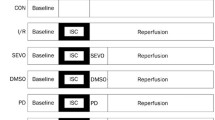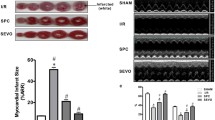Abstract
The roles of reactive oxygen species (ROS), extracellular signal-regulated kinase 1/2 (ERK 1/2) and mitochondrial permeability transition pore (mPTP) in sevoflurane postconditioning induced cardioprotection against ischemia-reperfusion injury in Langendorff rat hearts were investigated. When compared with the unprotected hearts subjected to 30 min of ischemia followed by 1 h of reperfusion, exposure of 3% sevoflurane during the first 15 min of reperfusion significantly improved functional recovery, decreased infarct size, reduced lactate dehydrogenase and creatine kinase-MB release, and reduced myocardial malondialdehyde production. However, these protective effects were abolished in the presence of either ROS scavenger N-acetylcysteine or ERK 1/2 inhibitor PD98059, and accompanied by prevention of ERK 1/2 phosphorylation and elimination of inhibitory effect on mPTP opening. These findings suggested that sevoflurane postconditioning protected isolated rat hearts against ischemia-reperfusion injury via the recruitment of the ROS-ERK 1/2-mPTP signaling cascade.




Similar content being viewed by others
References
Obal D, Dettwiler S, Favoccia C, Scharbatke H, Preckel B, Schlack W (2005) The influence of mitochondrial KATP-channels in the cardio protection of preconditioning and postconditioning by sevoflurane in the rat in vivo. Anesth Analg 101:1252–1260
Lucchinetti E, da Silva R, Pasch T, Schaub MC, Zaugg M (2005) Anaesthetic preconditioning but not postconditioning prevents early activation of the deleterious cardiac remodelling programme: evidence of opposing genomic responses in cardio protection by pre- and postconditioning. Br J Anaesth 95:140–152
Deyhimy DI, Fleming NW, Brodkin IG, Liu H (2007) Anesthetic preconditioning combined with postconditioning offers no additional benefit over preconditioning or postconditioning alone. Anesth Analg 105:316–324
Bein B, Renner J, Caliebe D, Scholz J, Paris A, Fraund S, Zaehle W, Tonner PH (2005) Sevoflurane but not propofol preserves myocardial function during minimally invasive direct coronary artery bypass surgery. Anesth Analg 100:610–616
Nader ND, Li CM, Khadra WZ, Reedy R, Panos AL (2004) Anesthetic myocardial protection with sevoflurane. J Cardiothorac Vasc Anesth 18:269–274
Conzen PF, Fischer S, Detter C, Peter K (2003) Sevoflurane provides greater protection of the myocardium than propofol in patients undergoing off-pump coronary artery bypass surgery. Anesthesiology 99:826–833
De Hert SG, ten Broecke PW, Mertens E, Van Sommeren EW, De Blier IG, Stockman BA, Rodrigus IE (2002) Sevoflurane but not propofol preserves myocardial function in coronary surgery patients. Anesthesiology 97:42–49
De Hert SG, Cromheecke S, ten Broecke PW, Mertens E, De Blier IG, Stockman BA, Rodrigus IE, Van der Linden PJ (2003) Effects of propofol, desflurane, and sevoflurane on recovery of myocardial function after coronary surgery in elderly high-risk patients. Anesthesiology 99:314–323
Di Lisa F, Ziegler M (2001) Pathophysiological relevance of mitochondria in NAD(+) metabolism. FEBS Lett 492:4–8
Di Lisa F, MenabòR Canton M, Barile M, Bernardi P (2001) Opening of the mitochondrial permeability transition pore causes depletion of mitochondrial and cytosolic NAD+ and is a causative event in the death of myocytes in postischemic reperfusion of the heart. J Biol Chem 276:2571–2575
Klingenberg M (1985) Determination of NAD, Methods of enzymatic analysis. In: Bergmeyer HU (ed) Spectrophotometric and fluorimetric methods. Verlagsgesellschaft, Weinheim, pp 253–271
Hausenloy DJ, Yellon DM (2004) New directions for protecting the heart against ischaemia-reperfusion injury: targeting the reperfusion injury salvage kinase (RISK)-pathway. Cardiovasc Res 61:448–460
Zhu M, Feng J, Lucchinetti E, Fischer G, Xu L, Pedrazzini T, Schaub MC, Zaugg M (2006) Ischemic postconditioning protects remodeled myocardium via the PI3K-PKB/Akt reperfusion injury salvage kinase pathway. Cardiovasc Res 72:152–162
Yang XM, Krieg T, Cui L, Downey JM, Cohen MV (2004) NECA and bradykinin at reperfusion reduce infarction in rabbit hearts by signaling through PI3K, ERK, and NO. J Mol Cell Cardiol 36:411–421
Darling CE, Jiang R, Maynard M, Whittaker P, Vinten-Johansen J, Przyklenk K (2005) Postconditioning via stuttering reperfusion limits myocardial infarct size in rabbit hearts: role of ERK1/2. Am J Physiol Heart Circ Physiol 289:H1618–H1626
Krolikowski JG, WeihrauchD Bienengraeber M, Kersten JR, Warltier DC, Pagel PS (2006) Role of Erk1/2, p70s6K, and eNOS in isoflurane-induced cardio protection during early reperfusion in vivo. Can J Anaesth 53:174–182
Toma O, Weber NC, Wolter JI, Obal D, Preckel B, Schlack W (2004) Desflurane preconditioning induces time-dependent activation of protein kinase C epsilon and extracellular signal-regulated kinase 1 and 2 in the rat heart in vivo. Anesthesiology 101:1372–1380
Hausenloy DJ, Mocanu MM, Yellon DM (2004) Cross-talk between the survival kinases during early reperfusion: its contribution to ischemic preconditioning. Cardiovasc Res 63:305–312
Chiari PC, Bienengraeber MW, Pagel PS, Krolikowski JG, Kersten JR, Warltier DC (2005) Isoflurane protects against myocardial infarction during early reperfusion by activation of phosphatidylinositol-3-kinase signal transduction: evidence for anesthetic-induced postconditioning in rabbits. Anesthesiology 102:102–109
Li H, Wang JK, Zeng YM, Yang CX, Chen HT, Wen XJ, Shui CL, Liang H (2008) Sevoflurane post-conditioning protects against myocardial reperfusion injury by activation of phosphatidylinositol-3-kinase signal transduction. Clin Exp Pharmacol Physiol 35:1043–1051
Chen HT, Yang CX, Li H, Zhang CJ, Wen XJ, Zhou J, Fan YL, Huang T, Zeng YM (2008) Cardio protection of sevoflurane postconditioning by activating extracellular signal-regulated kinase 1/2 in isolated rat hearts. Acta Pharmacol Sin 29:931–941
Nowak G, Clifton GL, Godwin ML, Bakajsova D (2006) Activation of ERK1/2 pathway mediates oxidant-induced decreases in mitochondrial function in renal cells. Am J Physiol Renal Physiol 291:F840–F855
Liu JC, Chan P, Chen JJ, Lee HM, Lee WS, Shih NL, Chen YL, Hong HJ, Cheng TH (2004) The inhibitory effect of trilinolein on norepinephrine-induced beta-myosin heavy chain promoter activity, reactive oxygen species generation, and extracellular signal-regulated kinase phosphorylation in neonatal rat cardiomyocytes. J Biomed Sci 11:11–18
Das S, Otani H, Maulik N, Das DK (2006) Redox regulation of angiotensin II preconditioning of the myocardium requires MAP kinase signaling. J Mol Cell Cardiol 41:248–255
Ping P, Zhang J, Cao X, Li RC, Kong D, Tang XL, Qiu Y, Manchikalapudi S, Auchampach JA, Black RG, Bolli R (1999) PKC-dependent activation of p44/p42 MAPKs during myocardial ischemia-reperfusion in conscious rabbits. Am J Physiol 276:H1468–H1481
Becker LB (2004) New concepts in reactive oxygen species and cardiovascular reperfusion physiology. Cardiovasc Res 61:461–470
Cohen MV, Yang XM, Liu GS, Heusch G, Downey JM (2001) Acetylcholine, bradykinin, opioids, and phenylephrine, but not adenosine, trigger preconditioning by generating free radicals and opening mitochondrial K(ATP) channels. Circ Res 89:273–278
Pain T, Yang XM, Critz SD, Yue Y, Nakano A, Liu GS, Heusch G, Cohen MV, Downey JM (2000) Opening of mitochondrial K(ATP) channels triggers the preconditioned state by generating free radicals. Circ Res 87:460–466
Kin H, Zhao ZQ, Sun HY, Wang NP, Corvera JS, Halkos ME, Kerendi F, Guyton RA, Vinten-Johansen J (2004) Postconditioning attenuates myocardial ischemia-reperfusion injury by inhibiting events in the early minutes of reperfusion. Cardiovasc Res 62:74–85
Sun HY, Wang NP, Kerendi F, Halkos M, Kin H, Guyton RA, Vinten-Johansen J, Zhao ZQ (2005) Hypoxic postconditioning reduces cardiomyocyte loss by inhibiting ROS generation and intracellular Ca2+overload. Am J Physiol Heart Circ Physiol 288:H1900–H1908
Kevin LG, Novalija E, Stowe DF (2005) Reactive oxygen species as mediators of cardiac injury and protection: the relevance to anesthesia practice. Anesth Analg 101:1275–1287
Stowe DF, Kevin LG (2004) Cardiac preconditioning by volatile anesthetic agents: a defining role for altered mitochondrial bioenergetics. Antioxid Redox Signal 6:439–448
Kevin LG, Camara AK, Riess ML, Novalija E, Stowe DF (2003) Ischemic preconditioning alters real-time measure of O2 radicals in intact hearts with ischemia and reperfusion. Am J Physiol Heart Circ Physiol 284:H566–H574
Tanaka K, Weihrauch D, Kehl F, Ludwig LM Jr, LaDisa JF, Kersten JR, Pagel PS, Warltier DC (2002) Mechanism of preconditioning by isoflurane in rabbits: a direct role for reactive oxygen species. Anesthesiology 97:1485–1490
Müllenheim J, Ebel D, Frässdorf J, Preckel B, Thämer V, Schlack W (2002) Isoflurane preconditions myocardium against infarction via release of free radicals. Anesthesiology 96:934–940
Tsutsumi YM, Yokoyama T, Horikawa Y, Roth DM, Patel HH (2007) Reactive oxygen species trigger ischemic and pharmacological postconditioning: in vivo and in vitro characterization. Life Sci 811:1223–1227
Riess ML, Kevin LG, McCormick J, Jiang MT, Rhodes SS, Stowe DF (2005) Anesthetic preconditioning: the role of free radicals in sevoflurane-induced attenuation of mitochondrial electron transport in Guinea pig isolated hearts. Anesth Analg 100:46–53
Hanouz JL, Zhu L, Lemoine S, Durand C, Lepage O, Massetti M, Khayat A, Plaud B, Gérard JL (2007) Reactive oxygen species mediate sevoflurane and desflurane-Induced preconditioning in isolated human right atria in vitro. Anesth Analg 105:1534–1539
Kevin LG, Novalija E, Riess ML, Camara AK, Rhodes SS, Stowe DF (2003) Sevoflurane exposure generates superoxide but leads to decreased superoxide during ischemia and reperfusion in isolated hearts. Anesth Analg 96:949–955
Baines CP, Zhang J, Wang GW, Zheng YT, Xiu JX, Cardwell EM, Ping P (2002) Mitochondrial PKC epsilon and MAPK form signaling modules in the murine heart: enhanced mitochondrial PKCepsilon-MAPK interactions and differential MAPK activation in PKCepsilon-induced cardio protection. Circ Res 90:390–397
Baines CP, Song CX, Zheng YT, Wang GW, Zhang J, Wang OL, Guo Y, Bolli R, Cardwell EM, Ping P (2003) Protein kinase Cepsilon interacts with and inhibits the permeability transition pore in cardiac mitochondria. Circ Res 92:873–880
Eldar-Finkelman H, Seger R, Vandenheede JR, Krebs EG (1995) Inactivation of glycogen synthase kinase-3 by epidermal growth factor is mediated by mitogen-activated protein kinase/p90 ribosomal protein S6 kinase signaling pathway in NIH/3T3 cells. J Biol Chem 270:987–990
Juhaszova M, Zorov DB, Kim SH, Pepe S, Fu Q, Fishbein KW, Ziman BD, Wang S, Ytrehus K, Antos CL, Olson EN, Sollott SJ (2004) Glycogen synthase kinase-3beta mediates convergence of protection signaling to inhibit the mitochondrial permeability transition pore. J Clin Invest 113:1535–1549
Acknowledgments
The authors thank Miss Ding-Hua Liu for her excellent technical support.
Author information
Authors and Affiliations
Corresponding author
Rights and permissions
About this article
Cite this article
Yao, YT., Li, LH., Chen, L. et al. Sevoflurane postconditioning protects isolated rat hearts against ischemia-reperfusion injury: the role of radical oxygen species, extracellular signal-related kinases 1/2 and mitochondrial permeability transition pore. Mol Biol Rep 37, 2439–2446 (2010). https://doi.org/10.1007/s11033-009-9755-4
Received:
Accepted:
Published:
Issue Date:
DOI: https://doi.org/10.1007/s11033-009-9755-4




